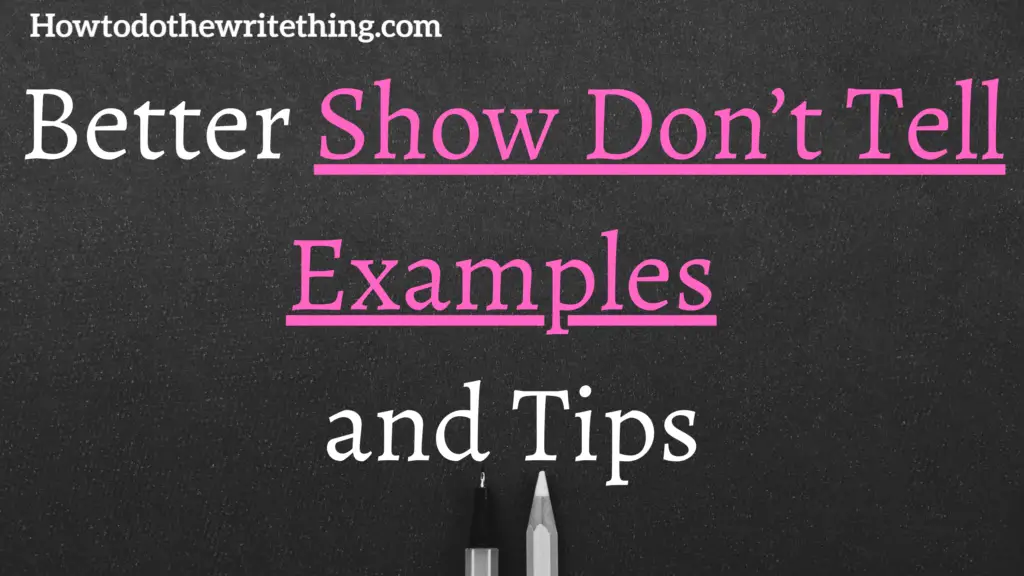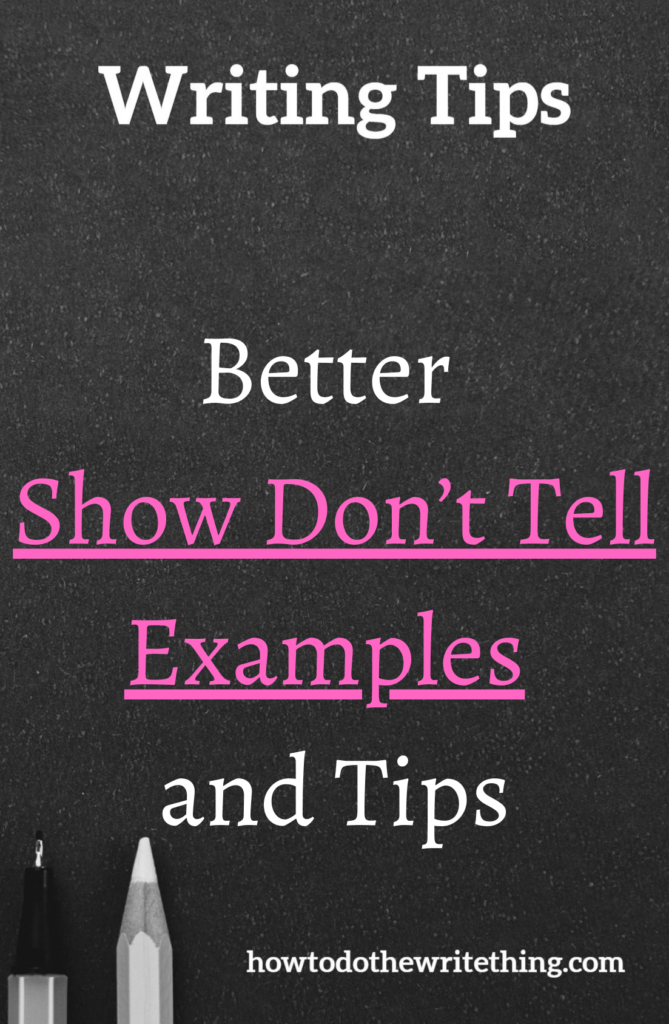
Better Show Don’t Tell Examples and Tips
So you want to be a better writer? And you think that learning how to better show and not tell will do it for you.
Well…
You’re right.
If you read the tips in this post and practice them over the next 3 months you WILL be a better writer.
Stop using “has.”
You might write something like this, “John has broad shoulders and brown hair,” but don’t instead find a way to show us John’s features.
“Candace turned around to John’s big shoulder in her way. “Excuse me Gronk, could you please watch where you’re swinging those things? You about bowled me over.”
John looked into the mirror brushing his brown hair back, trying to get it to swoop just right, “Sorry Candace, I didn’t know you were gonna turn around like that. Besides you’ve been in the bathroom for over 15 minutes. You’re gonna make the rest of us late.”
It is sooooo easy and tempting to just tell us what a person looks like, but if you find ways to get it out in detail without using has or is, you will teach yourself how to write better descriptions than 95% of writers.
(That’s not a scientific stat. I just made it up.)
But the point is you’ll definitely be a better writer and you’ll feel better writing out most descriptions too.
Stop saying “is.”
Don’t say, “Jamie is obsessed with Carter.”
Say something like, “If you were able to walk into Jamie’s room, you might mistake her for a stalker. You also might call Carter and warn him that Jamie is probably a dangerous person. If you counted up the photos that were printed off of social media of Carter in Jamie’s room it would add up to 104 photos and that’s excluding the categorized photo book hiding underneath Jamie’s bed.
Before you think, “that’s normal for a girlfriend to be a little obsessed with her boyfriend, Carter is not Jamie’s boyfriend.”
This isn’t the most amazing writing, but it portrays the point well. Don’t tell your reader that so and so is this or so and so is that. WRITE IT OUT.
It is difficult at first and it takes more time and thought to get what you want to say out there, but if you force yourself to write this way, your audience will enjoy the way you show them what’s going on instead of telling them.
You’ll do yourself a favor if you get rid of thought-verbs.
What are thought-verbs?
Here’s a list of thought-verbs:
- Knows
- Thinks
- Realizes
- Believes
- Wants
- Remembers
- Understands
- Imagines
- Etc.
There are a lot of them and you would do your writing skills a favor and be a pro at “show don’t tell” if you cut them out for the most part (granted there are places for these, but sparingly, and the more you force yourself not to use them the better. The more you rely on them the more it can be a cop-out.)
The thing with thought verbs is that your reader is the one who should imagine and think these things and realize them as you show them what’s going on.
For example, “Sam knew that Josiah didn’t like Karen.”
Instead of allowing the reader to “see” why Sam knew that Josiah didn’t like Karen, we’ve been lazy with this point when we could have come up with reasons WHY Josiah doesn’t like Karen or WHY Sam knows. (If it is an important point to the story or adds to the interest then try to put details into it instead of using thought verbs.)
Instead, we should give the reader evidence to follow for this statement first. We should feel like we have to PROVE it to our readers.
“Sam and Josiah sat down to have lunch. Karen immediately plunked down next to them. Sam saw Josiah’s expression drop. Karen immediately started talking. She talked about the news, the weather, and various things and never once asked either of them any questions. She just talked.
Sam tried to be polite and nod along with her and smile at the right moments, but he could see by Josiah’s expression that he had tuned her out. Eventually, Josiah just got up and left. Karen turned to Sam, “Did I say something wrong? Is he mad at me for some reason?”
Sam still trying to be polite said, “I’m not sure. I wouldn’t worry about it. He probably just has to use the restroom or something.”
This could use some editing but we get to see that Josiah doesn’t like Karen and we immediately get to see some reasons why he might not enjoy her company: she sits down uninvited, she doesn’t let them talk, she talks too much without asking questions or listening. These are normal human behavior that might not be malicious, but can often be taken as rude or annoying.
This can be done with any verb that is used to tell a reader what a character is experiencing without actually telling the reader why they are experiencing it.
Want to get paid to write? Check out Writing Paychecks
- There is a simple method over 30,000 people use to get paid for freelance writing online.
- Opportunities can get started in just minutes a day, all from your home couch.
- It’s easy to get started! No previous experience or degree required to start.
- Exclusive job listings for writers, updated daily.
Check out Writing Paychecks to see if you can start getting paid to write today.

“Don’t leave your characters alone.”
I don’t 100% agree with this advice. I’m biased though because Cast Away and I am Legend are some of my favorite stories. This is definitely the outlier and not the norm.
I understand the advice though. Not leaving your characters alone very much is an easier way to avoid thought-verbs. When your character is alone it is more tempting to just tell the reader what the character is feeling, thinking, and imagining rather than trying to show them.
It is almost like we put ourselves in a corner and there is no way out without telling the reader what is going on in our character’s head, but we can get around this even if we decide to challenge ourselves with a solo character story or scene.
“John sat in his hotel room worried that Sarah wouldn’t make it in time.”
Instead, try to show them John’s feelings about his current situation. If John’s worried, he’s not gonna be kicked back eating a bon-bon watching Dr. Phil.
He might be pacing, looking out the window, or checking his watch.
“John was alone in room 102. He kept looking thru the window curtain with one eye to see if Sarah was in the parking lot. Each minute passed by like an hour. He kept checking his watch. After 34 minutes had painstakingly gone by he started to sweat. He went into the bathroom and turned on the sink to cold. He splashed cold water on his face and tried to breathe, just breathe. His entire body jolted when there was a knock at the door.”
Personally, I think a scene where our character is alone is the perfect way to add power to the crisis or moment that otherwise might have been missed if we didn’t put the character into a solo situation. We can talk about what they were experiencing and use description to show our readers what they were feeling.
It also can make a scene feel more intimate when we are alone with the character. As a reader, an alone scene can be a powerful moment for us to connect with a certain character. We get to see them at their most vulnerable moments: when they are alone.
So in my opinion don’t shy away from solo scenes, just remember that it’ll be just a bit harder to really get some ideas of what they are thinking and feeling across, but in the end, this could add more emotion to the character that can make our reader feel closer to them.
Final thoughts
In general, the resounding advice here is to watch out for just throwing in a verb to tell our reader about a character’s thoughts or feelings. If we go through our writing and see that we have used a lot of verbs to tell our reader stuff we should go back and try to prove to the reader in the details and describe why that statement is true.
Lead your reader to the thought. Then if you decide you still want to state it as a fact, you can.
“Tom was waiting for Carol at her locker with a bright white smile. “Hey, babe. I missed you at the game last night. I got you these though.” Tom handed her a box of nerds. Carol let out a little squeal of excitement and ripped open the box. They started walking together. They both went to the same gym class.
“You want some?” She said with her mouth half full.
“Nah, you enjoy every last one.” It was little things like this that made Carol love Tom. He always did little things to make her day better, to make her happier. She couldn’t count on her fingers and toes all the things he had done for her in the past year together. It seemed like he was never concerned about himself and she had never found that in a guy before.
Derek her last boyfriend, asked her almost weekly to write a song for him about how much she loved him. Needless to say, that relationship didn’t last too long. Tom wasn’t just “her type.” He was different than any other guy she had ever met.”
In the example above, there is some showing and some telling. I didn’t detail or describe every single verb or action I chose to talk about. It would get a bit ridiculous if you did this. But I did show reasons why Carol could subjectively have feelings of love for Tom before ultimately choosing to still state it, “It was the little things like this that made Carol love Tom.”
And you don’t have to show and then tell. You don’t have to throw in the statement at the end, but the point here is you can if you still want to.
And that is how I would address most “Rules” in writing. They are meant to help you write better, but knowing when and how much to use them is important.
The important takeaway from tips like these is that you will be a much better writer if you force yourself to acquire the skill of proving the statements you want to make with actions, details, and descriptions for the readers to see in their imagination.
When you are able to pull this writing skill out of your bag of tricks then you will be able to discern when to use it and when to cut back on it. Just because something is good doesn’t mean you should use it always and everywhere.
“Thinking is abstract. Knowing and believing are intangible. Your story will always be stronger if you just show the physical actions and details of your characters and allow your reader to do the thinking and knowing. And loving and hating.” – Chuck Palahniuk
This post was inspired by Chuck. Chuck has some amazing writing advice that will put you leagues ahead if you take it to heart and practice what he teaches. Shout out to Chuck! Thank you, Chuck!
Enjoying Better Show Don’t Tell Examples and Tips? Take a moment and consider sharing this social-friendly image to say thanks and feel free to comment with your thoughts below! 🙂


Want to get paid to write? Check out Writing Paychecks
- There is a simple method over 30,000 people use to get paid for freelance writing online.
- Opportunities can get started in just minutes a day, all from your home couch.
- It’s easy to get started! No previous experience or degree required to start.
- Exclusive job listings for writers, updated daily.
Check out Writing Paychecks to see if you can start getting paid to write today.



That’s all for now.
Hope this helps!
Happy writing!
Another Post you Might like:
Mythical Creatures | 7 Tips on How to Write Mythical Creatures
Other Popular Posts you might enjoy:
5 Tricks How to Hide Your Villain Right Before Their Eyes
10 Tips How to Write Villains that Play Mind Games with Their Victims
4 Tips How to Write your Character Hitting Rock Bottom
10 Toxic Bad Habits That’ll Crush Your Fictional Character’s Relationships
How to Write From Your Villain’s Mind.
How To Write 4 Scenes That Reveal Who Your Character Is Seamlessly
Psychopath: How to Write The Perfect Psychopath
Other Resources You Might Enjoy:
How to Start a Blog in 11 Simple Easy Steps in 2020
How to Write a Book: 32 Tips | Your MASSIVE Guide How to Write a Book
Interested in starting a blog of your own? Check out Bluehost.
Make sure your posts are readable. Use this readability score check
Want to check out a writer’s community to test your writing and get feedback?
Check out these FREE trial resources from Amazon for when you work from home (or are stuck at home 🙂 ) As an Amazon associate, if you do sign up or buy anything using Amazon links from our site we make a commission at no extra cost to you.
Free Prime Membership Trial:
Try Amazon Prime 30-Day Free Trial
Try Prime Discounted (Free Trial)
Get Unlimited Music for Free (30-day free trial):
Free Baby Registry:
Shop Amazon – Create an Amazon Baby Registry
Make your Free Amazon Wedding Registry:
Create an Amazon Wedding Registry
Enjoying Better Show Don’t Tell Examples and Tips? Take a moment and consider sharing this social-friendly image to say thanks and feel free to comment with your thoughts below! 🙂


